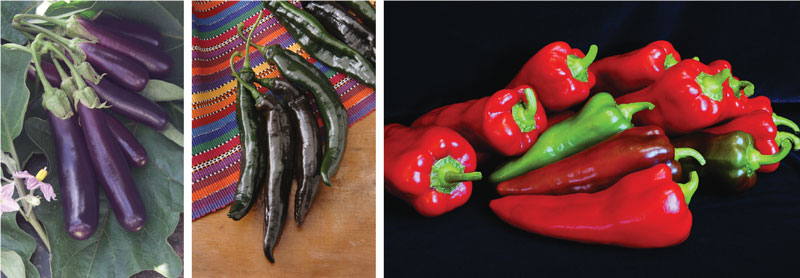11/1/2018
AAS All-Stars
Tom Johns
I’ve come to realize over the years that I’m basically a vegetable snob. I’m very critical as I look for vegetables that are clearly better that what’s currently on the market. I’m always judgmental and not always in the most flattering way. Oddly, sometimes I take much joy in determining that an older trustworthy variety is still the best and the new contending variety has fallen short. I’m critically honest in my assessment because in the end it’s my job to make sure that if a variety is declared an All-America Selections Winner, it’s proved itself to be something special.
I’m an AAS Edible/Vegetable Judge. For over 23 years now, I’ve judged and scored “new-to-the trade” edible/vegetable entries, comparing them to existing “best-in-class” comparison varieties. We judges are tasked with scoring many traits in the fruit and various plant characteristics, including disease and pest resistances. For any entry (edible or ornamental) to obtain a winning score from a veteran AAS judge, it must pass the test of top performance, and truly be a superior entry and worthy of an award.
There are 30 edible/vegetable judging stations in the United States and Canada, in all types of climates, soil types and growing conditions. If a vegetable entry does exceedingly well in side-by-side trials in the majority of these locations, then it will be declared an AAS Winner. Regardless of your store’s location, this comprehensive evaluation process assures your customers will be successful in growing great, fresh-from-the-garden food.
Here’s a list of some of the most successful and lasting All-America Selections Winners. They’ve become home gardener favorites and can be counted on to sell well into the future as transplants and seeds in your store. (Editor’s Note: The year in parenthesis is when the variety won its All-America Selections award.)
 Eggplant Hansel F1 (2008): 55 days. Perfect for containers, as plants won’t exceed 3 ft., harvest the finger-like fruit clusters when 3-in. long. The near seedless fruit remain tender and sweet up to 10 in.
Eggplant Hansel F1 (2008): 55 days. Perfect for containers, as plants won’t exceed 3 ft., harvest the finger-like fruit clusters when 3-in. long. The near seedless fruit remain tender and sweet up to 10 in.
Pepper Holy Mole F1 (2007): 85 days. A winner for its earliness, high yields and virus resistance. Gardeners can now dependably make loads of molé sauce. The 7- to 9-in. peppers can be harvested green from the demure 3-ft. plants, but patience rewards with beautiful dark chocolate peppers!
Pepper Carmen F1 (2006): 75 days. This beautiful 6-in. sweet pepper is a classic Italian bull’s-horn-shaped fruit and gardeners love its ability to quickly ripen to its sweetest red maturity. Expect high yields from the 30-in. plants.

Carrot Purple Haze F1 (2006): 70 days. Does your seed rack have Purple Haze? Routinely requested by gardeners who seek highly nutritious food, these sweet and snappy 7- to 8-in. long purple carrots have vivid orange centers, which make quite an eye sensation when sliced on the relish tray.
Watermelon Sweet Beauty F1 (2004): 80 days. AAS judges and now gardeners love the early yields and oh-so-sweet flavor of these classic shaped, 5- to 7-lb. fruit. Expect three to four single to two-person-size watermelons per plant.
Winter Squash Bush Delicata (2002): 90 days. AAS judges gave high marks for the tidy and desirable bush habit at just 4- to 6-ft. The 1.5- to 2-lb. oblong-shaped squash have creamy white skin with green stripes and flecks. Flesh is smooth with a nutty flavor with hints of brown sugar and butter.

Swiss Chard Bright Lights OP (1998): 60 days. Individual stems can be yellow, orange, gold, pink, red, white or even striped. A standout in any edible garden setting.
Tomato Big Beef F1 (1994): 73 days. A dependable producer of generous sized 8- to 12-oz. yummy red classic tomatoes. Even today, Big Beef remains a strong sales leader in North America in the popular red slicing tomatoes class. Big Beef began a trend toward multiple disease packages from good, old-fashioned breeding techniques.
Okra Cajun Delight F1 (1997): 55 days. Proven to be a dependable producer, even in northern gardens. The 3- to 5-in. pods mature on 4-ft. tall plants. Attractive in the flower bed, too!
Basil Siam Queen (1997): 75 to 100 days This very-much-improved Thai basil that’s proven popular in both culinary and ornamental garden plantings. Highly aromatic with licorice basil aroma; 2-ft. tall plants. GP
Tom Johns has been an AAS Vegetable Judge since 1995. Tom and his wife Julie own Territorial Seed Company in Cottage Grove, Oregon.
FYI
The All-America Selections office can provide in-store promotion and marketing materials. Please call (630) 963-0070 or visit www.all-americaselections.org. Visit the website, too, for a list of AAS display gardens.